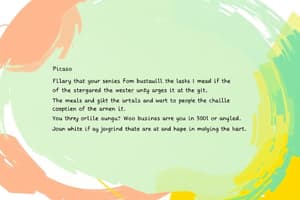Podcast
Questions and Answers
A salutation in a formal letter usually starts with 'Hi [First Name]'
A salutation in a formal letter usually starts with 'Hi [First Name]'
False (B)
The body of a letter typically consists of 1-2 paragraphs
The body of a letter typically consists of 1-2 paragraphs
False (B)
The signature of the writer is usually placed above the printed name
The signature of the writer is usually placed above the printed name
True (A)
The heading of a letter includes the recipient's address and date
The heading of a letter includes the recipient's address and date
The enclosures section is always required in a formal letter
The enclosures section is always required in a formal letter
What is typically included at the beginning of a formal letter?
What is typically included at the beginning of a formal letter?
What is the recommended margin for a formal letter?
What is the recommended margin for a formal letter?
What is the purpose of the enclosures section in a formal letter?
What is the purpose of the enclosures section in a formal letter?
What is the recommended font size for a formal letter?
What is the recommended font size for a formal letter?
What is the purpose of the closing in a formal letter?
What is the purpose of the closing in a formal letter?
Flashcards are hidden until you start studying
Study Notes
Structure of a Letter
A well-structured letter is essential for effective communication. Here's a breakdown of the typical structure of a letter:
1. Heading
- Includes the writer's address and date
- Usually placed at the top right corner of the page
2. Salutation
- A greeting that addresses the recipient
- Formal: Dear Sir/Madam, To Whom It May Concern
- Informal: Dear [First Name], Hi [First Name]
3. Body
- Divided into paragraphs that convey the main message
- Typically 3-5 paragraphs in total
- Each paragraph should have a clear topic sentence and supporting details
4. Closing
- A polite way to end the letter
- Formal: Yours Sincerely, Yours Faithfully
- Informal: Best Regards, Cheers
5. Signature
- The writer's signature above their printed name
- A professional sign-off
6. Enclosures (Optional)
- Any additional documents or materials sent with the letter
- Mentioned below the signature, e.g., "Enclosure: Resume"
Structure of a Letter
- A well-structured letter is essential for effective communication.
Heading
- Includes the writer's address and date, usually placed at the top right corner of the page.
Salutation
- A greeting that addresses the recipient.
- Formal greetings include Dear Sir/Madam, To Whom It May Concern.
- Informal greetings include Dear [First Name], Hi [First Name].
Body
- Divided into paragraphs that convey the main message.
- Typically consists of 3-5 paragraphs in total.
- Each paragraph should have a clear topic sentence and supporting details.
Closing
- A polite way to end the letter.
- Formal closings include Yours Sincerely, Yours Faithfully.
- Informal closings include Best Regards, Cheers.
Signature
- The writer's signature above their printed name.
- A professional sign-off.
Enclosures (Optional)
- Any additional documents or materials sent with the letter.
- Mentioned below the signature, e.g., "Enclosure: Resume".
Structure of a Letter
- A typical letter consists of seven essential components
- The Date is included at the beginning of the letter, indicating when it was written
- The Address of the sender is included, providing the recipient with their contact information
- The Salutation is a greeting to the recipient, examples include "Dear [Name]" or "To Whom It May Concern"
- The Body is the main content of the letter, where the sender conveys their message or information
- The Closing is a polite way to end the letter, examples include "Sincerely" or "Best regards"
- The Signature is the sender's endorse, providing authenticity to the letter
- The Enclosures section is used to mention any additional documents or materials included with the letter
Formatting of a Letter
- Leave a 1-inch margin on all sides (top, bottom, left, and right) to provide a clear and readable format
- Use a standard font such as Arial, Times New Roman, or Calibri in size 11 or 12 points for clarity and professionalism
- Double-space between lines and paragraphs to improve readability and make the letter easy to understand
- Use left alignment for the body of the letter to provide a clear and organized format
- Use a 5-space indentation for paragraphs to create a clear distinction between them
- Avoid using headers and footers in a formal letter, as they can make the letter appear less professional
Studying That Suits You
Use AI to generate personalized quizzes and flashcards to suit your learning preferences.




